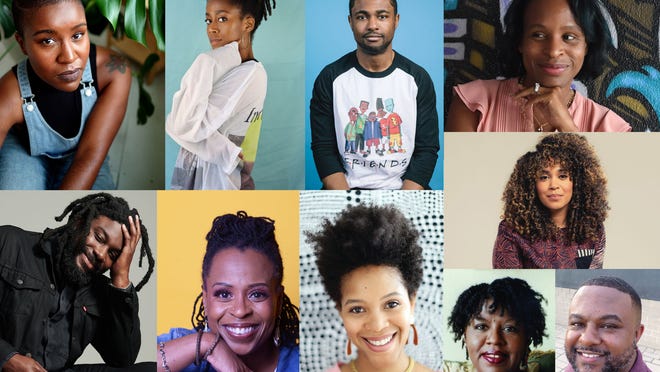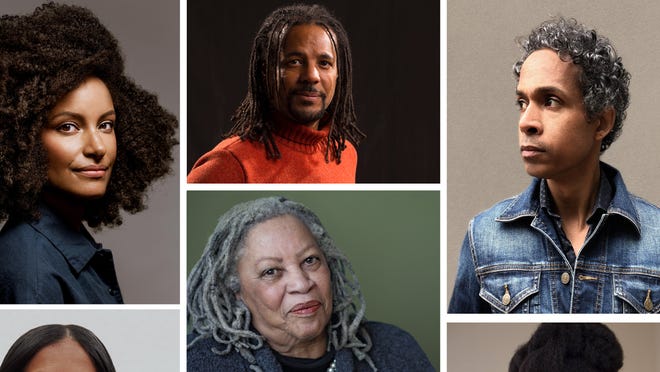This Black History Month – and all year – make sure your bookshelf reflects the diversity of the world. Or take matters into your own hands and write such a book yourself.
For example: George Floyd’s murder sparked global Black Lives Matter protests in the summer of 2020. It also sparked an idea in writer-illustrator Dapo Adeola’s mind.
Around that time, “I tweeted about how, in children’s picture books, we get to discuss a variety of different topics but we never talk about race in a manner that is talking to the people that it affects,” Adeola says.
He decided to write such a book and focus on joy amid the pain – “Hey You!: An Empowering Celebration of Growing Up Black,” (Nancy Paulsen Books, out now) – and collaborated with other illustrators to bring his vision to the page. Expect sweet images of children reading in school and listening to music, but also more mature ones of protest and police brutality.
“We touch on things,” Adeola says of the heavier topics. “We don’t go in-depth. What we’re trying to do is we’re trying to give parents a gateway to have certain conversations. Children are curious.”
Attention, adults:10 must-read Black History Month book recommendations: Cicely Tyson, Angie Thomas and more
Political analyst Bakari Sellers had his own 3-year-old toddlers in mind when writing his book, “Who Are Your People?” (Quill Tree Books, out last month). It features images of important figures like Muhammad Ali, Stacey Abrams and Vice President Kamala Harris, as well as important moments like former president Barack Obama’s campaign and the restaurant sit-in movement.
“When raising them, I wanted them to be able to see their reflection in their images and the pages they read, and the images they see on TV,” Sellers says. “And that wasn’t the case.”
Beyond these titles, parents can look to many different books to ensure their child has a diverse leading list during Black History Month (and beyond).
“Parents need to know that it is OK for their children to read books with characters that are different from them,” says Shauntee Burns-Simpson, associate director of school support and outreach at the New York Public Library. “As long as the story engages them, sparks curiosity, their child will experience the joy of reading.”
Looking for books about racism? Experts suggest these must-read titles for adults and kids

For the youngest kids and elementary school set
“I’m Growing Great“
Author: Mechal Renee Roe
Synopsis: “Set in a backdrop of nature’s glorious color and bounty, it’s the perfect springtime read-aloud to promote confidence and self-esteem for girls of all ages.”
“Dream Street“
Author: Tricia Elam Walker; illustrated by Ekua Holmes
Synopsis: “Welcome to Dream Street – the best street in the world! Jump rope with Azaria – can you Double Dutch one leg at a time? Dream big with Ede and Tari, who wish to create a picture book together one day.”
“Milo Imagines the World“
Author: Matt de la Peña; illustrated by Christian Robinson
Synopsis: “Milo is on a long subway ride with his older sister. To pass the time, he studies the faces around him and makes pictures of their lives.”
“The 1619 Project: Born on the Water“
Author: Nikole Hannah-Jones and Renée Watson; illustrated by Nikkolas Smith
Synopsis: “The 1619 Project’s lyrical picture book in verse chronicles the consequences of slavery and the history of Black resistance in the United States, thoughtfully rendered by Pulitzer Prize-winning journalist Nikole Hannah-Jones and Newbery honor-winning author Renée Watson.”
Ooh:‘Ramón and Julieta’ and ‘Black Love Matters’ top USA TODAY’s February rom-com reading list
For the almost-teens
“Stuntboy, in the Meantime“
Author: Jason Reynolds; illustrated by Raúl the Third
Synopsis: “Portico Reeves’s superpower is making sure all the other superheroes – like his parents and two best friends – stay super. And safe. Super safe. And he does this all in secret. No one in his civilian life knows he’s actually…Stuntboy!”
“Ain’t Gonna Let Nobody Turn Me ‘round: My Story of the Making of Martin Luther King Day“
Author: Kathlyn Kirkwood; illustrated by Steffi Walthall
Synopsis: “This brilliant memoir-in-verse tells the moving story of how a nation learned to celebrate a hero. Through years of protests and petition, Kathlyn’s story highlights the foot soldiers who fought to make Martin Luther King Jr.’s birthday a national holiday.”
“Black Boy Joy: 17 Stories Celebrating Black Boyhood“
Author: Kwame Mbalia (editor)
Synopsis: “From 17 acclaimed Black male and non-binary authors comes a vibrant collection of stories, comics, and poems about the power of joy and the wonders of Black boyhood.”
‘Black Joy’:Inspiring new book reminds Black Americans happiness looks beautiful on them
For the teens and YA set
“Required Reading for the Disenfranchised Freshman“
Author: Kristen R. Lee
Synopsis: “A stunning, challenging, and timely debut about racism and privilege on college campuses.”
“Hurricane Summer“
Author: Asha Bromfield
Synopsis: “Tilla has spent her entire life trying to make her father love her. But every six months, he leaves their family and returns to his true home: the island of Jamaica. When Tilla’s mother tells her she’ll be spending the summer on the island, Tilla dreads the idea of seeing him again, but longs to discover what life in Jamaica has always held for him.
In an unexpected turn of events, Tilla is forced to face the storm that unravels in her own life as she learns about the dark secrets that lie beyond the veil of paradise – all in the midst of an impending hurricane.”
“Revolution in Our Time: The Black Panther Party’s Promise to the People“
Author: Kekla Magoon
Synopsis: “‘Revolution in Our Time’ puts the Panthers in the proper context of Black American history, from the first arrival of enslaved people to the Black Lives Matter movement of today.”
‘Decolonize your bookshelf’:Little libraries, book boxes promote conversation about race in America
Why representation in children’s books matters
Children need to read about experiences beyond their own – and that doesn’t mean just one book once a year for Black History Month.
“Hopefully, when white kids or other kids read (“Who Are Your People?”), they will be able to understand the culture, and the circumstances and the personalities that make the person that they’re playing in the sandbox with, or that they go to school with, and parents they drink coffee with,” Sellers says.
“The Black experience is not monolithic,” Adeola says. “But it gives you a little insight into part of Black experience, in terms of what children that don’t look like yourself, if you’re not Black, might face growing up in the world that we live in.”
People have sent Adeola videos of parents reading his book to their children, siblings reading it to each other and parents reading on their own – the exact audience he envisioned.
And books shouldn’t have to specifically focus on Black history, but feature protagonists of all different backgrounds to better reflect the world.
That could lead to a more inclusive future. “Maybe I’m not yet jaded by reality, but I still believe there’s more that brings us together than divides us,” Sellers says. “And that requires us to read as much as possible.”
Contributing: Mary Cadden
Add this to your list, too:What kids should be reading for AAPI Heritage Month and why representation matters


